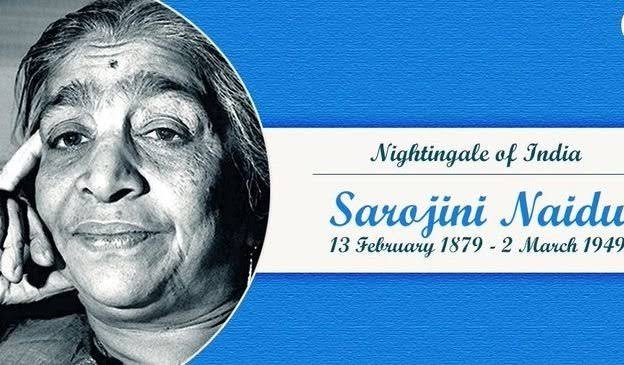Sarojini Naidu, was an illustrious woman in Indian struggle for independence from colonial directive.
Sarojini Naidu, an Indian political activist and poet. A adherent of civil rights, woman’s liberalisation and anti-imperialistic ideas, she was an illustrious figure in Indian politics during India’s struggle for independence. Naidu work as a poetess, social activist and politicians.
Sarojini was the first born daughter of Aghorenath Chattopadhyay, a Bengali Brahman who was principal of the Nizam’s College, Hyderabad. She set her foot in the University of Madras at the age of 12 and educated from king’s College, London and later at Girton College, Cambridge.
Naidu was the second Indian woman who became president of Indian National Congress. She was famously known as ‘The Nightangle of India’. She wave up against partition of Bengal, 1905. At that time she came into exposure with leaders such as Gopal Krishna Gokhale, Rabindranath Tagore, Annie Basant, Jawaharlal Nehru and Mahatma Gandhi. During that period of time between 1915 and 1918, Sarojini Naidu travelled to different regions of India for Social welfare, woman empowerment and nationalism.
She creates awareness among the woman of our country. She help to established the woman’s India Association (WIA) in 1917, and she was sent to London with Annie Basant, the president of WIA, to care about the voteing right for woman and to the joint select committee.
In 1925, Sarojini Naidu conduct the annual session of Indian National Congress in Kanpur. In 1929, she superintendent over the East African Indian, Congress in South Africa. She glory with the Kaiser-i-Hind medal by the British government for her task during the plague an important role in Round Table Conference and Civil Disobedience Movement and was jailed with Gandhiji and other leader, Sarojini Naidu was apprehend during Quite India Movement and imprison for 21 month with Gandhiji.
Sarojini Naidu was an eminent poetess in Indian Literature as she produced many lyrics in a variety of vernacular languages including Sanskrit, Prakrit, Pali, Bengali, Hindi, Telegu, Urdu and many other languages. The term Indian literature used to refer to Indian produced accross the Indian subcontinent to the creation of the Republic of India in 1947 and after 1947. The brief therapy of Indian literature were falls like Islamic literature, The art of Bangladesh, South Asian arts: Literature.
Sarojini Naidu was famous for her skills and ability, at the age of twelve she starts her literary work. Her first collection of poems ‘The Golden Threshold’ was published in 1905. The volume books were being introduced by Arthur Symons. Her poem was very much admirable for Indian politician like Gopal Krishna Gokhale. Her notable works like ‘In the Bazars of Hyderabad’, ‘Gift of India’, ‘The Broken Wing’,’The Feather of Dawn’. Her poem generally divided in many part with deep philosophy of spiritualism and from the thematic point of view, The categories such as nature poem, love poem, patriotic poems, poems of life and death, poems of Indian scene.
Her poetic style were being followed the great English poetic tradition where she used many meter and rhyme apart from these poetic cries of joy, sorrow, fervon,and exultation. As a poet Sarojini Naidu was sway by some great English poet like Tennyson, Shelly and Browning. Her skills touched the readers heart with full of enthusiasm they enjoy the poems.
Sarojini Naidu, who worked on her own inch of ivory. That’s why her poems were being admirable not only for India, but all over the world. Rishi Aravinda, Tagore, Gandhi and Nehru were among the thousand of admires of her work.
As Sarojini Naidu, a woman who thought about the woman empowerment in 19th century society, where woman were being treated very badly, she inspired an entire generation of woman to actively engaged with freedom movement,that time she became an ideolozed for every woman of society. She was firey supported, equal access to education for each and every girl.
Naidu had continual dedication to gender equality fundamentally establish the position of woman in India. She had the thought that without woman, there is no nation, because freedom from colonization was so desperately sought after. She wants to risk sacrificing the movement’s due to internal tension of woman engaged in the struggle.
It caused by gender discrimination. The fact that the female alliance played a vital role during Gandhi’s Salt March. As a highly educated woman were involved in the active politics of the congress party. She was the symbol of femele evacuation. Naidu’s silks and ability itself present a controversial part in the eyes of British and allowing woman to British and allowing woman to educate and to hold office. As, Sarojini Naidu was became the Governer of Uttar Pradesh (United Provinces).
As, on March 2, on the birth anniversary we all celebrate as ‘woman’s day’ in India. To give esteem to woman of our country. As it is pride for our whole country as we get Naidu as a fetish for our nation.
Rabindranath Tagore- The 1st Indian who won the Noble Prize in literature.




